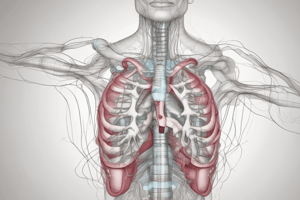Podcast
Questions and Answers
What is the primary function of the respiratory system?
What is the primary function of the respiratory system?
- To regulate blood sugar levels
- To remove carbon dioxide from the body (correct)
- To facilitate speech and smell
- To regulate body temperature
Which component of the respiratory system is responsible for gas exchange?
Which component of the respiratory system is responsible for gas exchange?
- Larynx
- Bronchi
- Alveoli (correct)
- Trachea
What happens during inhalation?
What happens during inhalation?
- The diaphragm relaxes and rises
- The air leaves the lungs
- The rib cage decreases in size
- The diaphragm contracts and flattens (correct)
What is the role of chemoreceptors in the regulation of breathing?
What is the role of chemoreceptors in the regulation of breathing?
Where is the control center for breathing located?
Where is the control center for breathing located?
What is the purpose of exhalation?
What is the purpose of exhalation?
What is the role of the pharynx in the respiratory system?
What is the role of the pharynx in the respiratory system?
What is the term for the movement of oxygen from the alveoli into the bloodstream?
What is the term for the movement of oxygen from the alveoli into the bloodstream?
Flashcards are hidden until you start studying
Study Notes
Functions of the Respiratory System
- Brings oxygen into the body
- Removes carbon dioxide from the body
- Regulates pH levels by removing excess hydrogen ions
- Helps to regulate blood pressure
- Facilitates speech and smell
Components of the Respiratory System
- Upper Respiratory Tract
- Nose and mouth (entry points for air)
- Pharynx (throat)
- Larynx (voice box)
- Lower Respiratory Tract
- Trachea (windpipe)
- Bronchi (airways)
- Bronchioles (smaller airways)
- Lungs (alveoli, where gas exchange occurs)
Mechanism of Breathing
- Inhalation
- Diaphragm contracts and flattens
- Intercostal muscles contract, causing rib cage to expand
- Air enters lungs through nose or mouth
- Air passes through trachea, bronchi, and bronchioles
- Air reaches alveoli, where oxygen diffuses into bloodstream
- Exhalation
- Diaphragm relaxes and rises
- Intercostal muscles relax, causing rib cage to decrease in size
- Air leaves lungs through nose or mouth
Gas Exchange
- Oxygen
- Diffuses from alveoli into bloodstream
- Binds to hemoglobin in red blood cells
- Transported to body tissues
- Carbon Dioxide
- Diffuses from bloodstream into alveoli
- Exhaled out of the body
Regulation of Breathing
- Control Centers
- Medulla oblongata (brainstem)
- Pons (brainstem)
- Sensors
- Chemoreceptors (detect changes in CO2 and O2 levels)
- Stretch receptors (detect changes in lung volume)
- Regulation Mechanisms
- Negative feedback loops to maintain homeostasis
- Adjustments to breathing rate and depth based on CO2 and O2 levels
Functions of the Respiratory System
- Brings oxygen into the body and removes carbon dioxide
- Regulates pH levels by removing excess hydrogen ions
- Helps to regulate blood pressure
- Facilitates speech and smell
Components of the Respiratory System
Upper Respiratory Tract
- Nose and mouth are the entry points for air
- Pharynx, also known as the throat, is a part of the upper respiratory tract
- Larynx, also known as the voice box, is responsible for speech production
Lower Respiratory Tract
- Trachea, also known as the windpipe, is a tube that connects the throat to the lungs
- Bronchi are the airways that branch off from the trachea
- Bronchioles are smaller airways that branch off from the bronchi
- Lungs are responsible for gas exchange, where oxygen is taken in and carbon dioxide is removed
Mechanism of Breathing
Inhalation
- Diaphragm contracts and flattens, increasing the volume of the chest cavity
- Intercostal muscles contract, causing the rib cage to expand
- Air enters the lungs through the nose or mouth
- Air passes through the trachea, bronchi, and bronchioles, reaching the alveoli
Exhalation
- Diaphragm relaxes and rises, decreasing the volume of the chest cavity
- Intercostal muscles relax, causing the rib cage to decrease in size
- Air leaves the lungs through the nose or mouth
Gas Exchange
Oxygen
- Diffuses from the alveoli into the bloodstream
- Binds to hemoglobin in red blood cells
- Transported to body tissues, where it is used for cellular respiration
Carbon Dioxide
- Diffuses from the bloodstream into the alveoli
- Exhaled out of the body through the lungs
Regulation of Breathing
Control Centers
- Medulla oblongata, located in the brainstem, is responsible for controlling breathing
- Pons, located in the brainstem, is also involved in controlling breathing
Sensors
- Chemoreceptors detect changes in CO2 and O2 levels in the bloodstream
- Stretch receptors detect changes in lung volume
Regulation Mechanisms
- Negative feedback loops maintain homeostasis by adjusting breathing rate and depth
- Adjustments to breathing rate and depth based on CO2 and O2 levels in the bloodstream
Studying That Suits You
Use AI to generate personalized quizzes and flashcards to suit your learning preferences.




